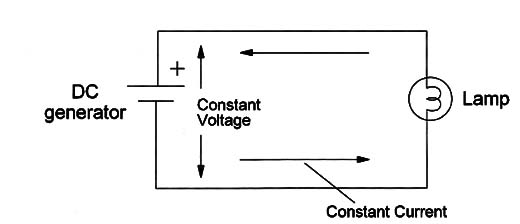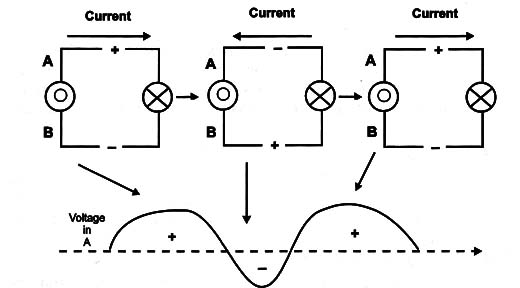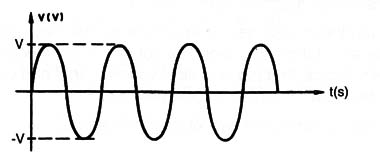In basic examples used to show how an electric circuit works, we supposed energy sources or generators with special characteristics. In the poles of these generators we found a constant voltage meaning that when a constant resistance circuit was wired to them, the current flow was established in one direction with a constant value.
This circuit operates with a DC or direct current generator and the current through all its elements is referred to as DC (Figure 1).

Through this circuit, the electrons can move only in one direction, transporting energy from the generator to a device or load. Cells, batteries, and dynamos are DC generators as the voltage found in their poles is constant.
On the other hand, the electrician who works with electric installations knows that the electricity supplied to buildings is not DC, but AC or alternating current.
What is the difference and what does it mean? It is not necessary to have a constant flux of charges or constant current flow through a device to transport energy to it. Figure 2 shows a generator that changes the voltage in its terminals at high speed.

One moment pole A is positive and B is negative. The electrons are pumped through the device being used as load (a lamp, for example) releasing their energy and heating the filament. The lamp glows.
An instant later, the poles of A and B are inverted. The electrons are now pumped in the opposite direction but must pass through the filament of the lamp again releasing energy.
The lamp continues to glow. If the generator continues to change its poles, the electrons are pumped forward and backward through the circuit.
Observe that in this process, the charges move only a microscopic distance in one direction, then reverse motion so the charge retraces its path. The action is repeated continually so that the actual average movement of the charges is zero.
But, a current flows because the charges are in motion. This is enough to cause an oscillating movement of the electrons in the circuit and to transfer energy from the generator to the load (any device that can absorb energy). This kind of current moving forward and backward is alternating current (AC).
The curious fact to be observed is, although the electrons move only a few centimeters each second, the force that pumps the electrons acts as a wave that moves near the speed of the light through the wires.
In domestic installations the AC energy found in outlet jacks changes its poles 120 times by second, or 60 times in a second a pole is positive and 60 times is negative. We say that the frequency of the AC power line is 60 hertz (60 Hz). This is standard in most countries, but in some it is 50 Hz.
The alternating current found in the AC power line has a special waveform of variation represented by a curve shown in Figure 3.

This is a the curve of a trigonometric function called sine and it shows that the voltage across of the poles of an AC generator changes slowly from the positive to the negative passing across the zero point, pumping the electrons forward and backward through a circuit.
When working with electronics, the reader can find both DC circuits and AC circuits.
The circuits powered from batteries or cells are DC circuits. The stages of these circuits are powered from DC sources but they can have some parts where AC currents are found. In general, AC currents ranging from low to high frequencies found in these circuits are called signals. They are used to transport some kind of information like sounds or images.
For the circuits powered from AC power, there are three situations to take into consideration:
1. Some use only AC in their circuits such as the ones used to control AC appliances (motors, lamps, etc).
2. Some use AC in the input but convert it to DC and then DC is used in almost all the internal circuits.
3. Some can use both AC and DC depending on the stage. And, in many stages we can find 60 Hz AC currents and signals ranging from a few hertz to hundreds or thousands of megahertz.
This means that the reader working with electronic equipment must be prepared to find both AC and DC voltages independent of the used power supply.




